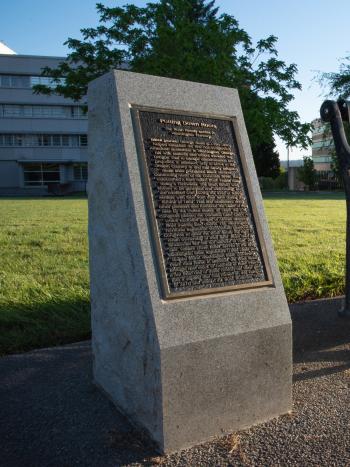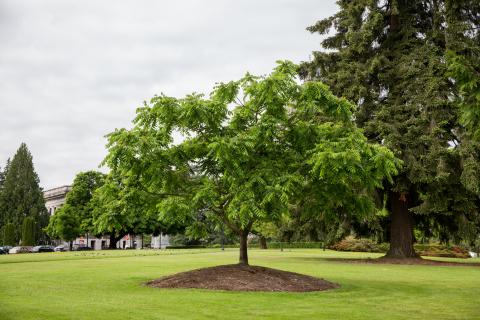A stone marker, and a live tree, honor Black settler George Bush

Bush’s 1845 settlement may have made Washington Territory possible. Learn more about his contributions to state history.
The state Capitol has more than 20 public artworks, memorials and monuments. A bench and granite marker on the campus’ west lawn is a testament to the role of Black settler George Bush in the founding of our state.
The Washington State Historical Society and the Department of Enterprise Services (DES) installed the granite marker in November 2021. Funding for the memorial came in part from leadership by former Rep. Eric Pettigrew and the state Legislature’s Black Members Caucus.
Historical accounts describe Mr. Bush as a former trapper with experience in the Pacific Northwest. Traveling companions and future neighbors says that Bush and his wife—a free Black man and a woman of Irish ancestry—were coming west to build a future free of racial discrimination.
But in 1844, as they neared the end of the Oregon Trail, the Oregon Territory’s provisional government barred Black settlement. Bush’s wagon party turned north, settling near the site of the town Bush would also help to found: Tumwater.
This was a time of international struggle between the U.S. and England, which had laid claim to the same lands. The English ran Fort Vancouver, far to the south, and Fort Nisqually, nearer, to the west. When they arrived in 1845, Bush’s wagon party established the only American settlement north of the Columbia.

His tenure may have led to the creation of the Washington Territory. As Portland State University professor of history Darrell Millner wrote:
Some historians suggest that [Bush’s] decision [to settle at Tumwater] played a large part in the eventual British-American compromise that created the modern Canadian border and gained possession for America of the present-day state of Washington.
For the next few years, settlers struggled to build homes and grow crops. Bush never turned away appeals for aid from his neighbors during that time—nor later, as an increasing number of Americans headed north toward new American settlements on Puget Sound.
Bush’s hospitality earned him immense public gratitude. In 1854, the newly established Washington territorial legislature petitioned Congress to exempt Bush’s family from the racial restrictions of the Donation Land Act. Congress granted this exception on Feb. 10, 1855, 170 years ago this month. Bush and his family remained on their 880-acre farm well into the 20th century.
Bush’s legacy endures in the form of the Bush Butternut, a tree growing just steps from his bronze and granite memorial. It’s a white walnut that DES planted in 2010 on the Capitol’s west lawn, grown from a cutting taken from an ancient tree that Bush had carried, as a seed, over the Oregon Trail.
Visit the George Bush Marker on the walking path between the World War II Memorial and the Sunken Garden. The Bush Butternut Tree stands to the north.

